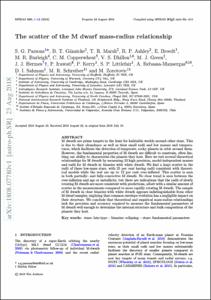Exploració per tema "Estels binaris"
Ara es mostren els items 1-9 de 9
-
Detached cataclysmic variables are crossing the orbital period gap

(2016-04-21)
(2016-04-21)
Article
Accés obertA central hypothesis in the theory of cataclysmic variable (CV) evolution is the need to explain the observed lack of accreting systems in the similar or equal to 2-3 h orbital period range, known as the period gap. The ... -
Double degenerate mergers as progenitors of high-field magnetic white dwarfs

(2011-04-10)
(2011-04-10)
Article
Accés obertHigh-field magnetic white dwarfs have been long suspected to be the result of stellar mergers. However, the nature of the coalescing stars and the precise mech anism that produces the magnetic field are still unknown. ... -
Full orbital solution for the binary system in the northern Galactic disc microlensing event Gaia16aye

(EDP Sciences, 2020-01-21)
(EDP Sciences, 2020-01-21)
Article
Accés obert
Realitzat a/amb: Obserwatorium Astronomiczne Uniwersytetu Warszawskiego / Instytut Astronomiczny Uniwersytetu Wrocławskiego / Instituto de Astrofìsica de CanariasGaia16aye was a binary microlensing event discovered in the direction towards the northern Galactic disc and was one of the first microlensing events detected and alerted to by the Gaia space mission. Its light curve ... -
Monte Carlo simulations of post-common-envelope white dwarf + main sequence binaries: The effects of including recombination energy

(2014-08-20)
(2014-08-20)
Article
Accés obertContext. Detached white dwarf + main sequence (WD+MS) post-common-envelope binaries (PCEBs) are perhaps the most suitable objects for testing predictions of close-compact binary-star evolution theories, in particular, ... -
The difficulty of finding double-degenerate progenitors of type Ia supernovae

(2018)
(2018)
Text en actes de congrés
Accés obertThe double-degenerate progenitors of type Ia su- pernovae (SNIa) are double white dwarf binaries with a totalmass near the Chandrasekhar limit and with merger timescales smaller than the Hubble time. The fact that we ... -
The mass function of hydrogen-rich white dwarfs: robust observational evidence for a distinctive high-mass excess near 1 M-circle dot

(2015-09-11)
(2015-09-11)
Article
Accés obertThe mass function of hydrogen-rich atmosphere white dwarfs has been frequently found to reveal a distinctive high-mass excess near 1 M-circle dot. However, a significant excess of massive white dwarfs has not been detected ... -
The scatter of the M dwarf mass-radius relationship

(Oxford University Press, 2018-11-21)
(Oxford University Press, 2018-11-21)
Article
Accés obertM dwarfs are prime targets in the hunt for habitable worlds around other stars. This is due to their abundance as well as their small radii and low masses and tempera- tures, which facilitate the detection of temperate, ... -
The white dwarf binary pathways survey – VIII. A post-common envelope binary with a massive white dwarf and an active G-type secondary star

(Oxford University Press, 2022-12-01)
(Oxford University Press, 2022-12-01)
Article
Accés obertThe white dwarf binary pathways survey is dedicated to studying the origin and evolution of binaries containing a white dwarf and an intermediate-mass secondary star of the spectral type A, F, G, or K (WD+AFGK). Here we ... -
Where are the double-degenerate progenitors of Type Ia supernovae?

(Oxford University Press, 2019-01-01)
(Oxford University Press, 2019-01-01)
Article
Accés obertDouble white dwarf binaries with merger timescales smaller than the Hubble time and with a total mass near the Chandrasekhar limit (i.e. classical Chandrasekhar population) or with high-mass primaries (i.e. sub-Chandrasekhar ...










